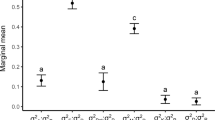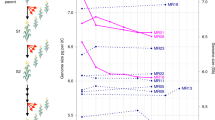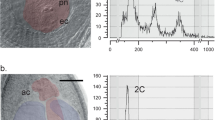Abstract
SOMATIC seed polymorphism is the production of seeds of different morphologies or behaviour on different parts of the same plant and is a somatic differentiation rather than the result of genetic segregation1. This phenomenon appears to be confined to a limited number of families of higher plants (for example, Cruciferae, Compositae, Chenopodiaceae, Gramineae). Seed produced within a somatic polymorphism may vary in size (Xanthium sp.2), colour (Atriplex heterosperma Bunge3) and/or external structure (Chenopodium album L.4). These variations in morphology are frequently accompanied by differences in germination requirements with the consequence that the germination of polymorphic seeds may be staggered in time. Such somatic channelling of progeny into distinct classes of behaviour may increase the fitness of individuals in environments that are temporally patchy, at the expense of the intrinsic rate of increase that could be attained by a unique seed type in a uniform environment. It might be expected that somatic seed polymorphism would also be found in species occupying habitats that are patchy in space and under these circumstances polymorphism in dispersal mechanisms could also be anticipated. One reported case may come in this category; Gymnarrhena micracantha Desf.5, a desert annual, produces numerous small aerial wind-dispersed achenes (the fruit in Compositae is usually termed an achene but is strictly a pseudo-nut as the pericarp is partly axial and there is more than one carpel6) and also larger subterranean achenes close to the parent plant. The wind dispersed achenes are produced in greater numbers in years with high rainfall. The subterranean achenes serve only to establish descendants in the safe sites previously occupied by their parents. We report here an even more striking polymorphic dispersal mechanism in the biennial Picris echioides L. (Compositae).
This is a preview of subscription content, access via your institution
Access options
Subscribe to this journal
Receive 51 print issues and online access
$199.00 per year
only $3.90 per issue
Buy this article
- Purchase on Springer Link
- Instant access to full article PDF
Prices may be subject to local taxes which are calculated during checkout
Similar content being viewed by others
References
Harper, J. L. Population Biology of Plants (Academic, London, 1977).
Crocker, W. Bot. Gaz. 42, 265 (1906).
Frankton, C. & Bassett, I. J. Can. J. Bot. 46, 1309–1313 (1968).
Williams, J. T. & Harper, J. L. Weed Res. 5, 141–150 (1965).
Koller, D. & Roth, N. Am. J. Bot. 51, 26–35 (1964).
Willis, J. C. Dictionary of Flowering Plants and Ferns (Cambridge University Press, 1960).
Black, J. N. Aust. J. agric. Res. 7, 98–109 (1956).
Sorensen, A. E. thesis, Univ. North Wales (1978).
Zohary, D. & Imber, D. Heredity, 18, 223–231 (1963).
Author information
Authors and Affiliations
Rights and permissions
About this article
Cite this article
SORENSEN, A. Somatic polymorphism and seed dispersal. Nature 276, 174–176 (1978). https://doi.org/10.1038/276174a0
Received:
Accepted:
Issue Date:
DOI: https://doi.org/10.1038/276174a0
This article is cited by
-
Ecotypic differentiation and phenotypic plasticity combine to enhance the invasiveness of the most widespread daisy in Chile, Leontodon saxatilis
Scientific Reports (2017)
-
Can natural selection maintain long-distance dispersal? Insight from a stream salamander system
Evolutionary Ecology (2012)
-
Reproductive ecology of Thymelaea velutina (Thymelaeaceae)- Factors contributing to the maintenance of heterocarpy
Plant Systematics and Evolution (2005)
-
Diversity in seed germination behavior in relation to heterocarpy inSalsola komarovii Iljin
The Botanical Magazine Tokyo (1991)
-
Population ecology of halophyte seeds
The Botanical Review (1987)
Comments
By submitting a comment you agree to abide by our Terms and Community Guidelines. If you find something abusive or that does not comply with our terms or guidelines please flag it as inappropriate.



